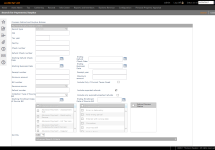Refund
Navigate:  Tax
> Accounts
Receivable > Manage
Payments > Refund
Tax
> Accounts
Receivable > Manage
Payments > Refund
Description
Use the Refund screens to view refund details for a payment and post the refund. Multiple amounts can be refunded as part of a single transaction.
When working with Refund transactions, you can generate and view both a Refund/Overpayment Listing and refund notice directly from the Payment Search Results screen. These two print buttons are located in the title bar of the Search Results grid. Once generated, the listing/vouchers are displayed automatically in a separate window.
Steps
To refund a payment:
-
On the Search for Payments/Surplus screen, enter your search criteria and click Search.
-
On the Post Refund screen, review the list of payments to be refunded.
- In the Recipients panel, click the pencil icons to edit an address or refund, or click the Plus button to add recipients on the Address Details screen.
- Click Post Refund.
-
On the Transaction Confirmed screen, review the refund information.
- Click Refund Report to generate a report for the selected recipients on the screen.
NOTES:
-
The refund process defaults the 'Pay to' address to the override address entered during a tax correction process. The override address is then the one used on the refund screen via Tax > Accounts Receivable > Manage Payments > Refund.
-
A barcoded, pre-populated refund transaction notice correspondence to the taxpayer is generated to batch processes automatically as part of the Refund process.
Workflow
The Post Refund screen is also accessed, if applicable to your jurisdiction, via the View My Worklist screen from the Workflow icon in the sidebar on any screen. When accessed via the workflow, the screen contains additional buttons, such as Submit to Approve and/or Accept/Reject, depending on your jurisdictional requirements and workflow queue setup.
NOTE: Workflows available for this task vary. Your Aumentum Implementation team sets up each workflow specific to your jurisdiction and requirements.
IMPORTANT: When a refund item has an active workflow associated with it, you cannot select it for processing from other tasks. Instead, a warning message displays indicating that the item is in an active workflow. For example, if you are processing a surplus and select an item for workflow processing in the Surplus payment management task, you cannot process a refund for the surplus until the item is no longer in the workflow.
NOTE: The System Administrator at your jurisdiction can configure the Cancellation - No Surplus payment management process to require a workflow for each item via Configuration > Workflow Configuration.
Dependencies, Prerequisites and Setup
Configuration Menu
-
Flag Setup – The Refund Created With Outstanding Taxes flag is created automatically during the deploy process.
-
The Combine refunds during the refund workflow batch process application setting lets you combine refunds when the refund name and address is the same during the refund workflow batch process. To set this up:
- Click Configuration > Application Settings.
- On the Maintain Application Settings screen, select Effective Date from the Setting type drop-down list, and select Tax Accounts Receivable from the Sort by module drop-down list.
- Locate Combine refunds during the refund workflow batch process and click Edit.
- In the Setting Value column, select the checkbox to set it to True and click Apply.
- Click Save in the Command Item bar.
-
The application setting Flag Type to copy from Surplus to Refund Payment Export determines the flag type (which is a systype called Flag Type) to apply to a surplus to be flagged during payment export (for example, to any refund record requiring warrant pick-up by the Treasurer-Tax Collector’s office reported on the Auditor’s Report). The flag is initially set on a surplus via the Surplus Management task on the Manage Surplus screen, on which you can add and select the applicable flag type. Then, when managing the refund, if flagged, for example, as requiring warrant pickup, the surplus is not refunded to the account holder but is held for the Treasurer-Tax Collector.
